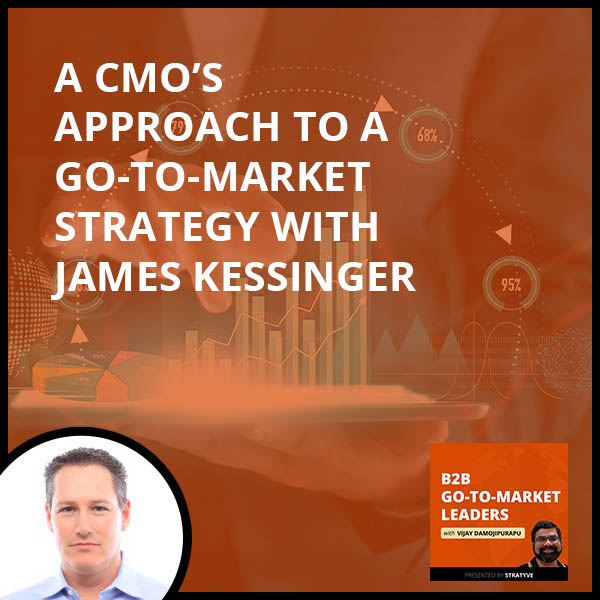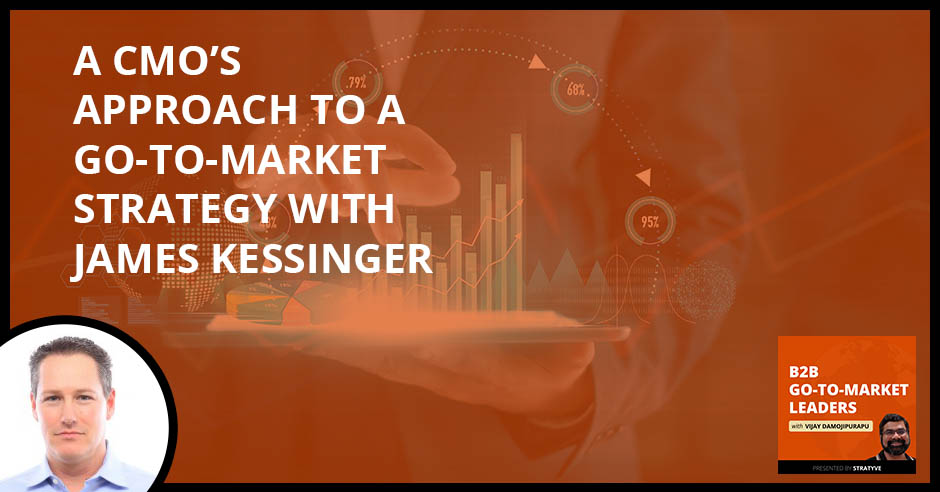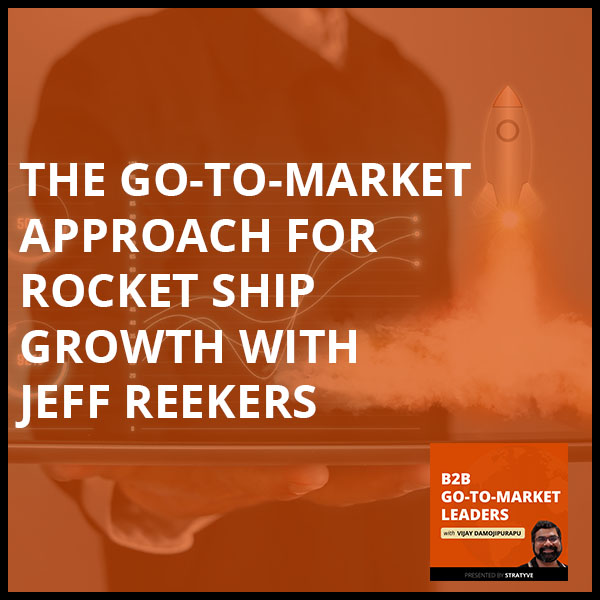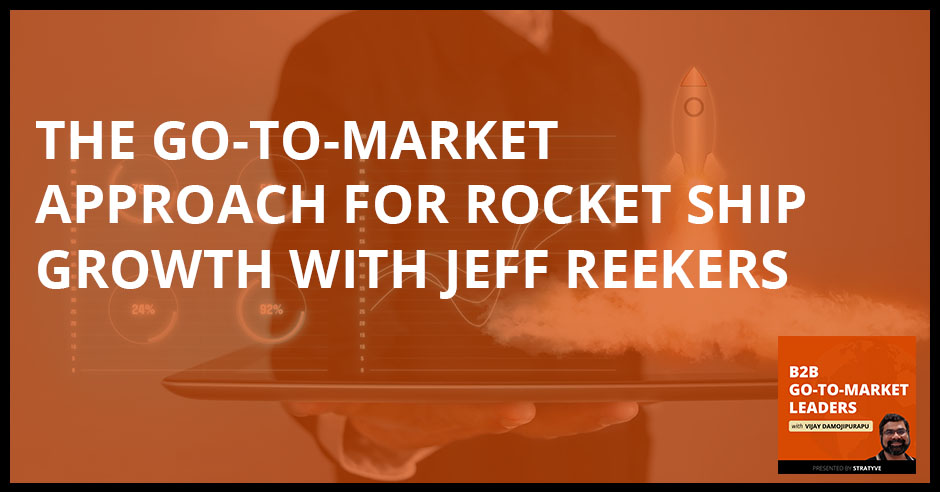

The go-to-market is all about connecting with your customers to buy your product or service. Who better to facilitate this than a Chief Marketing Officer? In this episode, Vijay Damojipurapu sits down with James Kessingerto discuss the vital role of the CMO in the go-to-market. James is the CMO of Hushly. Prior to that, he has been charting the waters of his career in the field of marketing, customer success, partnerships, revenue ops, and sales. He takes us across his journey and imparts great insights into a CMO’s approach under this strategy. James shares how he has shaped the go-to-market at Hushly and how it has evolved since taking on the role. He also talks about some of the go-to-market successes and failures he has observed, especially among marketers. Full of helpful information from his rich experience, James gives a great show to help you bring your strategy to success. Tune in to not miss out!
—
Listen to the podcast here
A CMO’s Approach To A Go-To-Market Strategy With James Kessinger
I have with me James Kessinger who is the CMO of Hushly. He’s coming from a very varied and accomplished background. We will get into a lot of those details during the episode. Stay tuned.
—
Welcome, James.
Thank you. It’s great to be here.
I always start the show with the signature question. How do you define go-to-market?
It’s always a fun one. I look at all teams in the company working toward a common set of goals with measurements and ownership of who’s doing what, which is ultimately led by a CEO. That person owns the go-to-market. At the end of the day, we all support that go-to-market function. That’s how I define it. It’s everybody working toward that common set of goals and with measurements because you have to have measurements.
You are the only one on the show who said that go-to-market is “owned“ by the CEO. No one has ever told me that.
I can’t change a sales comp. If you want to enter a new market or a new country, the CEO has to make decisions.
Both you and I and many others subscribe to what Sangram Vajre and his team and others are prescribing, which is go-to-market is not owned by one person. It should be owned by the CEO who has the entire gambit across all the functions. You did call about the CEO owning the metrics and then driving or guiding each of the functions but if you double–click, let’s go to the next layer, how would you as a CMO approach the go-to-market motion?
Largely, it comes down to what are we trying to achieve because my role is broader than the CMO aspect. I have to look at all functions, whether that’s customer success, sales, or even our dev op stuff, not just marketing. They all play a role in terms of what we’re trying to achieve and what we’re trying to do. Ultimately, once you’ve established this is what we’re trying to do, my job as a CMO, and probably most CMOs for that matter is to help orchestrate a lot of that to happen and making sure, “Is everybody pulling together? What do we have to do?”
Marketing touches everything from pre-sales all the way through post-sales and loyalty at the end of the day. That’s part of the go-to-market. You have to be able to touch the entire evolution of a customer and/or market on what you’re trying to do. That for me is understanding what we’re trying to achieve and who we need to rally together to get that because in the beginning, you may have to have a smaller set of folks and then broadly, you expand that out over time.
That’s all very internally focused. Let’s say you and the team are going after a specific market. How do you define the ICP? How do you do the research and the assumptions around your go-to-market?
We had to do this late last year because we were entering a brand new market that we had. We need data. Without that, you’re flying a little blind. You need to understand why are you making the decisions you’re going to make. For us, it came down to the data. I look at it as we had a set of customers that are more profitable than others but also, they’re using more of our products. The time to close is a little different and a little shorter. Ultimately, we have bigger relationships there.
For us, that was one of the reasons why we chose to nail down the cybersecurity path. We were heavy in technology as a company in terms of our market but when I look at it, let’s focus on this vertical specifically, which is cybersecurity. Is our ICP correct within this? Broadly, it’s correct for what we’re trying to do in tech but let’s make sure it’s correct here too.
That for me is where the data comes in. My job is to help look at how our past business has been looking from a close-one perspective. What do the deal sizes look like? How long does it take to close things? What are we losing? How much of the product are they using? It’s the consumption aspect of it. How many people do they have in the product? Can you start to define that ICP a bit more and then nail it? Ultimately, from there goes everything else. You have to get the messaging and your content ready. You have to start building things around that once you make a decision to go there but the data drives it, “Are you going in the right direction first? What direction should you be going?” That’s what we did.
The data really drives you in the right direction. Share on X
I’m sure we will double-click on several of the aspects over there. Let’s rewind a bit over here. Why don’t you walk us through your career path? You’ve got a very interesting career path. I‘ll double-click on several of the things but I want you to tell your story and how you became the CMO.
I’m the COO and CMO. It’s a bit of a dual role. I’ve been in Hushly for five years. I started as the CMO and moved into a broader role that encompasses more additional responsibilities. Overall, I’m responsible for marketing, customer success, partnerships, revenue ops, and sales. My career path didn’t start there. I started working in enterprise companies that were in growth mode at their time, which is pretty important to say because those companies today are either gone or in the twilight of their heyday if you want to call it that. I started at MCI Telecom.
Its heyday. It was outmaneuvering AT&Ts and Baby Bells way back then. I stayed there for four years. I went into Cisco which at the time in 1999 was a leader in networking and expanding out of their core customer base, which was enterprise, and moving into service providers. It was a new market with new buyers. They were expanding all their products and service business.
Ultimately, I spent fourteen years there. I spent quite a bit of time and did everything from services marketing, partner marketing, and segment marketing, which is the SMBs for service providers. I carried a bag. I was in sales for a couple of years. After Cisco, I went into a smaller company for about a year, ran their channel sales and marketing, got recruited to work in VMware, and ran their American big partner organization for about three years.
That’s where I cut my teeth and built my career because you could do so much in these big companies. I left the big company life and went into my first startup called CloudVelox. We got acquired VMware a year later, which was crazy. Instead of staying in IT, I was using the product of the company that I’m at now, which is Hushly. Rather than rejoin VMware, I jumped into the MarTech industry and moved to Hushly.
I can talk to CISOs and CIOs. You have all the messaging. You can talk to folks but it was interesting to me to talk to marketers, market to marketers, and sell to marketers. It was fun. That was what drew me there more than anything else. I get to touch technology, be involved with it, and talk to marketers pretty much all day, whether that’s practitioners, directors, or all the way to the CMOs. That for me was a fun run here for the last few years here. That’s my story.
You mentioned MCI. Here’s a little bit of my background. I came from India. I was doing my Master‘s. Back in those days, we were all purchasing the MCI calling cards to call back home. It was crazy. After that, I was in the telecom industry at Fujitsu Network Communications and even Microsoft. We were selling to MCI.
We got bought by WorldCom. UUNET was the actual backbone of the internet way back when. That was it. WorldCom became Verizon.
It looks like we might have interacted, not directly but we were selling to the same customers when I was at Microsoft working on the Mediaroom IPTV platform. You were maybe involved at Cisco in the IPTV world. We did cross paths but not directly. Here we are, finally touching ways.
It’s a small world.
You also mentioned selling two marketers in your role at Hushly. It’s almost like you are dogfooding your product and trying to showcase or get folks on the marketing side to adopt your product. That’s a challenge. I experienced that personally when I was at SugarCRM. I was a product marketing director there. I had to use the CRM but at the same time, I was selling to marketers and salespeople around CRM.
We’re all skeptical. I’m probably the biggest skeptic out there for sure. Our inboxes are full of marketing. Honestly, I get SDRs and PDRs. In every agency, everyone is flooding your inbox, and then you got the normal sales reps calling you and trying to sell everything. We are very skeptical buyers if you want to call it that, which is good. The good news is I understand that. I come from a level of understanding. It is about having to prove what you’re doing, which is good.
We’ve got a good product. Without a good product, it’s hard to do any marketing honestly because you’re fighting against your product. If you don’t have a good product in the market, it makes it much more challenging than if you’ve got a product that people care about. You’ve got advocates out there, you can show an ROI, and you’ve got people using it and willing to pay for it. That makes your job that much easier because you can now start to showcase and tell different stories versus if you’re making up a story that’s maybe not true.
Without a good product, it's really hard to do any marketing. Share on X
Your case is unique. Visual marketers get to that point. In your case, you were an avid user of Hushly. You loved the product and then moved over into Hushly, selling and getting others to adopt Hushly.
I was able to at least bang the drum before I got here. It was fun. It worked. The product worked for me, which is one of the selling points of why I came as well. It worked for me and I get it. These are problems that are in the industry. We were a single product back then. Now, we’re 9 or 10 products. It was unique. It solved a unique problem. It was a great story.
Let’s double-click on that. What does Hushly do? Who do you serve? Who are your customers? You mentioned marketing but let’s go into the use cases and the pain points that you solve.
For us, B2B companies or any industry is who we’re laser-focused on. It’s not a B2C. While it could be used there, we don’t go there. We’re heavy technology. We’re in cybersecurity. Our personas and the people that we sell to are digital marketers. They’re folks that care about SEO and SEM and paid marketers. Because we’re an experience and conversion platform, it comes down to the demand-gen marketer. You care about, “How do I activate my content? How do I educate buyers out there and get them to convert?” The demand-gen marketers are probably the main persona that we care about and sell to. Around that, it’s the content marketer. Content is the fuel for your engine.
If you think about the advent of the whole account-based marketing thing that has gone over the last few years, it’s field marketing. Field marketing and the ABM market are out there. They’re the ones that are at the pointy end of the spear because now you’ve got technologies like ours, 6sense, Demandbase, and the other guys. You’ve got the ability now to drive not just one-to-one models but one-to-one in a scalable fashion in terms of being able to use unique page ad things, different ad structures, all of the outbound sequences, and everything else.
It has made that marketer a little more efficient, and since that role has gotten bigger, the ABM marketers have. You have a little bit of that blended demand-gen and ABM marketer that we try to pull together because they’re critical for us. I see that one, and we have people buy our APM side of the platform. We get introduced to demand-gen marketers later.
That has been an interesting one. That’s the main one out there. The ones that are still there because I’m a big partner marketing guy are their partner marketers. There’s a lot of indirect stuff that goes on. They have these big MDF budgets. Is the vendor out there? How do I get partners to activate these partners on digital campaigns and be able to use our technology but at the same time, use our content and things and help them market better their services and their uniqueness?
Part of what at least I’ve been helping some of the partner marketing teams now do is leverage our technology and use it across however many vendors they want. The idea is to try to now tell a story but be scalable with what you’re doing, even if it’s making your Salesforce lounge. You’ve got another lounge over here at Cisco or whatever is in your quiver as a partner out there. You should be able to have different stories for different things, capture your leads as they come in, and understand those leads are attached to accounts.

I’ve been studying CMOs and something that sets up other CMOs and go-to-market executives in general is it typically revolves around three pillars, which is content, which you mentioned earlier. Build a winning go-to-market. It’s typically around content. You have a community, and then it’s experiences/events. These are the three typical playbooks that I’ve seen. There are more. I‘m curious. How have you shaped the go-to-market at Hushly? How has that evolved over time?
There are two things. As with any small company, it’s sales-led first directly. Unless you get out of the gate with a partner model, it’s sales-led. Now, with the advent of a lot of this product-led growth stuff where I can come on and turn on a product for somebody and let them try it, and then they hit their maximum pretty quick, “If you want more features turned on, give us money.” We started with sales-led growth. We have moved into some partner-led activities.
The community stuff is something that we’re part of but we’re not probably driving a large community. As we continue to go, I’m looking at where can I put my foot and my stamp on various other communities that help drive relevance for us because communities take a long time. You have to have somebody dedicated to that who can drive conversations, stimulate the community, and build the community for that matter. That’s a different lift.
PLG is a whole different motion. Your products, your back end, and everything have to be set up. Your sales model is different. Your marketing motions are different. Whenever you take any one of these go-to-markets, you have to be prepared for it and thought through. You have to think through what you’re going to do. We looked at PLG. We’ve got a couple of products we could probably turn into that but we need to make some fundamental changes in the product to do that.

Before, we were like, “We’re PLG.” Let’s fix these things and make sure that we’re ready to be one-touch because you don’t want to have a bad experience. The bad experience is going to screw you up. Once those things are done, then the rest of it you pull together, which is like, “The product is ready. Are the rest of the pieces of the puzzle ready to go with you?”
Especially the last piece that you mentioned around PLG takes me back to my time when I was hired at GoSite to lead their PLG effort. One of the things that we did was we said, “We are all in on PLG.” That was about 12 to 18 months prior to my joining. It’s hard to let go of your existing go-to-market motion that’s working. There are a couple of things. You want to target or move upmarket from micro. In our case, it was micro businesses like one owner to quantify employees and then move to 20 to 50 employees and above. We were selling primarily through inside sales.
That was still happening but at the same time, we wanted to go and move everything to PLG but there are bigger questions that we need to answer. First of all, are the buyers and the users that we are targeting comfortable trying the product on their own? Will they make the jump to move and purchase? Even prior to that, are there onboarding hurdles? Those are the challenges that we ran into.
Those are legitimate. Think about it. It’s the person in the company. If you say, “We’re SMB. We want to move to the enterprise,” that’s still a pretty big lift. You need a different Salesforce. You get a different comp structure. You need different marketing. Is your product ready? Is it enterprise-class? Here’s a short story on this one. In Cisco, we were going reverse. We were enterprise and certified. We started up this small business group. Think about it that way. It’s a purpose-built product and everything.
You can’t go down to the SMB and have an enterprise-lite product. You have to talk to the SMB. Small doesn’t mean stupid. We did all these focus groups. Small doesn’t mean we’re dumb. We’re businesspeople. We run a business. We don’t need an enterprise-lite product. We need an SMB product. It needs to fit what we’re trying to do. We did purpose-built products.
You have to do the work, whether that’s going up or you’re coming down, or whether you’re trying to do a completely different motion like the PLG versus a sales motion. You have to think through it. There’s a lot of big lifting that has to happen when you make one of those changes. The people that started a PLG product that want to go on sale are in the same boat. They have to now figure out, “What kind of salesperson would sell this thing?” It’s not going to be that you’re selling the PLG because you got that. What are you selling if you’re trying to sell it at the enterprise? Is it a seeding strategy? Do you need the seeding strategy wrap? You have to go through it.
We can go on different go-to-market mistakes but we’re not going to cover them in this episode for sure. Taking a step back more on the lighter side, how do your folks and your family describe what you do for work?
I have five little kids. I would say, “He talks on Zoom or Skype, sits on his computer all day, types on a keyboard, and makes some interesting pictures, graphics, and slides.” That would be pretty much the extent of “That’s what dad does. Dad says he’s in marketing but I don’t know.” It’s hard. I have elementary school kids. They’re not going to grasp what I’m doing, whether I like it or not.
Let’s get into the next section, which is around go-to-market successes and go-to-market failures. It’s a segment that the audiences love to dig into. As you and I know, go-to-market involves more often than not more failures than success stories. I‘ll leave it to you whether you want a success story or a failure story but we should cover both for sure.
We covered the success one a little bit earlier. It’s probably worth saying. At least I’m proud of it. The idea is to get alignment across all parts of the company and go after cybersecurity. It was nice to make a decision because it started with the data. It wasn’t a bunch of conjectures or somebody saying, “We have to go this way because we think it looks great.” You look at the data.
That for me was the big piece but before we were able to make that decision and before we had the data, I knew we were trying to do it. It was also about operational excellence. We had to get our operations in order because with startups, you can build and keep running, and you got a lot going, but if you don’t take the time to also connect a lot of the dots in your infrastructure, you have bigger headaches as you get bigger. I’ve seen that as well. As you get big, you got human middleware being thrown in there.
For me, the big piece was getting operationally efficient, meaning getting HubSpot working properly and understanding the data flows because we use it for CRM, not just the map. We’re using it for both mapping our product in there and what we’re doing with all the analytics platform stuff. Everything that we’re doing is pumping all that data in and understanding that 360 of the customer, where they began, where they ended, what they start using, how long it takes to onboard, and all that stuff.
Taking all those things into account was a success for us, and then being able to use that data, make a decision, ultimately move into that market, and full force head in there. I was in there a little earlier in November or December, but as a company, I was trying to seed. I’m doing more of a seeding strategy but then in January, we pulled budgets around there. We got things worked out on sales and CS.
Everyone is singing the same song sheet and driving through there. That for me was probably a good success. We’re seeing success. That is a good one to start with. When you think about go-to-market failures, God knows I got them from way back everywhere. It’s always interesting. I heard this from a leader way back, “Feedback is the breakfast of champions.” Whether you win or lose, you have to keep trying stuff, but making a decision that isn’t grounded in enough data is always a failure that marketing has to be aware of.
You can make decisions in sales, “This thing is going to probably come in. We know it’s coming in. We’ve got it as upside rather.” There’s enough data out there to understand that you only have about ten conversations that have happened. It takes twenty to be able to close a conversation. You’re not going to close this thing this quarter. You’re not near it. A lot of the predictive stuff is getting fine-tuned out there but marketing has always had that.
For us as marketers out there, your failure is going to start usually at the data. If you cut something too short, that’s a risk as well because if you cut it short, then not having enough runway and enough data to say whether something was a success or failure, that’s as bad because you’ve altered the outcome, “We’re going to run this for a quarter. This thing was terrible.”
As marketers out there, your failure is usually going to start with the data. Share on X
The reality is if you know your sales cycle is 6 months or 9 nine months, and you’re running campaigns, messaging, and stuff, it takes a while for some of these things to catch up. You have to understand you’re taking people on a journey with your content and your sales team. Everything is stitched together. You have to give them time to play out. What too many executives do, whether that’s CEOs, COOs, and even CROs because sales is guilty of this as well, is “This thing is not working. We have to get out of here.” it’s like, “It’s actually working. What we’re seeing is incremental successes come through.”
Ultimately, what you start to see down the road is you’ve got a close-one business and better engagement. You’re getting more at-bats. That’s where I’ve seen stuff for me in the past. I’ve cut it off too early and I make a conscious effort now to say, “This is going to run for this long. I want to see these milestones hit right in terms of some incremental successes along the way.” You have to be able to see some things because you have to tweak them.
Marketers always need to be trying things but also tweaking things. Ultimately, you’re trying to tweak it to make sure that it’s not just “We leave it out there. Hopefully, it works. It didn’t work.” You need to be working with it the whole way and understanding the ebbs and flows. Like ABM, you have to have weekly cadences with sales. You have to understand, “These things aren’t working. These 20 accounts are engaged while these 40 are not. Why are these guys engaged?”
It’s about digging into the details and the data, understanding and working the problems that you see, and ultimately trying to make these things successful. That for me is the big number. The biggest failure I see is not letting things run long enough and not using data to make decisions. Sometimes you have to buck the system, especially as a CMO. It’s a hard position to be in because you have to be able to tell the CRO. If you’re reporting to a CEO or COO, you have to tell them, “We’re going to lean into this a little further.” You have to make the call.

A lot of the time, you need to have a seat at the table. They have to respect you. Respect is earned and all that good stuff. At the end of the day, you’re there for a reason. You’re there because you know your job. You’re not the CRO doing the CRO’s job and predicting and forecasting. That’s not what you’re doing. You’re doing marketing and helping them tell the story, get the at-bats, and sell to accelerate. That’s where you need to be. You need to be able to own that and the market transitions, “We see a market transition happening. We need to be able to capture that.”
You covered a lot of important points when you were mentioning the success but more importantly when you’re talking about the failure. The key lesson that at least stood out for me was, first of all, not letting something run long enough. Typically, in go-to-market engines and teams, I’ve seen people try something for a couple of weeks or a month and then pivot.
It’s terrible. You can’t do that. If you’re going to do something that short, then don’t do it, honestly.
That’s one. The second one you talked about is around data or using data to make a decision either to pull the plug or to show that we are making incremental progress and then you continue that. Can you share a specific example? You did mention one around ICPs. Is there anything else that comes to mind either from VMware or Cisco?
We were doing a program. We built part of the marketing concierge. I was using an external agency to see “How do you help these smaller long-tail partners out there?” You have your top 100 if you want to call it that. They don’t usually need a lot. You give them some money, and you can approve their plans but then how do I help serve a lot of these long tails?
What we used was a concierge program. The concierge was like, “Think about the fractional CMO world of a fractional CFO. I have a marketing person that’s here to help you plan and execute marketing campaigns on your behalf.” For most of the smaller partners out there, it may be a team of one. Sometimes it’s a salesperson dumping as a marketing person.
It was a great success but you’re not going to see that right away because they’re in the same sales cycles as your company. What we’re able to start to show was that over time, they’re inbound because it’s now about the partner. The inbound leads for them were going up. Their meetings and at-bats were starting to go up. Their deal regs were going up. You saw that over the course of two quarters.
What you started to see were incremental things happening in Q1. A lot of things had to happen but when I started to do the measurements, it was like, “Let’s look at six months, and then we can reverse. Do we see any little things happening?” There are some green shoots here and there but broadly, what you started to see was that happening over the course of the year. We were able to do $400 million in the pipeline, which is pretty huge. I had a whole slide on the thing. We were able to do $80 million a quarter in a net new pipeline and activate partners that were selling either nothing or next to nothing for us.
This was for them a big boom because now they’re getting business from us and a little bit of money, which was a marketing concierge. How do we help them do that? For us, it was great because in the aggregate, looking at more of the program or the application of stuff. For individual partners, some did well, some didn’t, some did okay, and some didn’t do great. At that point, it’s like an ABM strategy.
You’re going to cull the herd a little bit, “These ones are doing good. Let’s put more in. Maybe we move them to a different model.” You begin to evolve but that for me was pure go-to-market play which was, “We need to do something not just for the 80/20 rule, probably 90/10,” 10% of your partners are probably driving 80% of your business, “How do I activate even the next level down because I can get these guys going for multibillion-dollar companies?” That can be a big jump. That’s important. When you get advocates, they’re going to get more certifications. They want to start selling your stuff.
One other thing that you touched upon earlier is we need to convince the CEO, the CRO, and others around, “We need to extend this initiative, campaign, or program a bit more even though we‘re not seeing.” That’s one area I have personally struggled with in my previous role. A COO and even the CEO asked me, “I‘m not seeing any leading indicators moving on this. Is this going to work for us or not on this specific paid digital as an example on LinkedIn or Facebook?”
There were some points where I said, “The data is showing otherwise,” but I had a tough time. It was a challenge for me personally, especially as someone like an INTJ who is very data–driven and thought–driven. I used to struggle to give a response. What is your advice? If a marketing leader is in that position, how would you frame that?
I can use my example in that one, especially ads because ads are very subjective but now, it has gotten a lot better. When I look at ads, let’s say LinkedIn. You can pretty much start to see early indications about what’s working or what’s not quickly. I’ve noticed that even with us. That’s where you’re not waiting a quarter to adjust your ad strategy for sure. That is a real-time endeavor that’s happening.
We’ve got five content pieces out there. We’re swapping them out every two and a half weeks with different ad structures and different-looking ads. Sometimes you’re re-skinning stuff every month but it’s because I’m seeing immediately when things are going up. They hit a plateau and then start to fall out. If I take that same ad and re-swizzle it with different content, a new call to action, and a different graphic, it can go right back up.
On those kinds of things, the leading indicator is, “How many downloads are we seeing? What are we seeing?” That’s an evolution. It’s the lead strategy. I’ve got leads coming in from various companies that are doing certain things. We’ve got them to dial this one thing from LinkedIn. We’re going to get them into a bit of a nurture flow. We want to get them back to our website and start consuming content.
That’s what we’re measuring, “How much consumption is happening? What personas do we see engaging with? Are these in our ICP?” All those come together, and then we start to see meeting requests coming through from these LinkedIn ads that were then on our side. You have to be able to start. That takes time. You turn on the garden hose. It has to go from the beginning all the way out toward spring. It’s the same thing with any of those strategies.
You have to have the ability to understand that you can affect some things upfront and tweak those things because if you don’t have ads that are working upfront, you’re going to know right away. You have to get your content right and your message right. You should start to see. Ultimately, the later stages are where you start to see, “The consumption is happening. The downloads are happening.” You start to see the demo request or the meeting starting to happen.
Those are long plays. That’s SEO. You have to get your domain authority. That’s a long putt. SEO is a year because you have to build it over time. You have to understand, “Are you going after your keywords and your long-tail keywords? You need a lot of content. You need to start getting rocking.” It takes time to build that up. That’s where the ad strategy can help you short-circuit some of that but it still takes time to get that earned media versus everything else.
Once those two strategies are together, your ads are probably going to be at the end of the day driving the majority of your inbounds and that stuff but over time, you will see that the other SEO that earned media is starting to drive as much if not more, helping your ads for that matter, giving you a little more lift than what you’re doing, and even reducing your cost of it as well. Those are where I see the big ones.
That’s a great explanation of that. You can attribute and measure the performance of many of the channels, especially digital. You can see the feedback loop coming in 1 to 2 weeks and know if it’s working or not. SEO will take time, six months at least, if it’s working or not but then there are other channels like a community or a podcast. You may not be able to show attribution right away.
It’s people doing the big awareness campaigns. The more you can push things out there about your brand and who you are, you’ve got a good community. You’re nurturing this community out there. Those are all seeds. You’re sprinkling seed in the ground at the end of the day because you’re trying to show thought leadership. You’re trying to show you’re different. You’re trying to get advocates out there.

Even if you’re not flogging everybody in the community about who you are, you’re stimulating conversations about B2B in this case. You’re having a B2B broad go-to-market conversation out there. It’s not like you’re trying to hammer somebody over the head with, “You have to buy this.” All those are seeds out there. Communities are good for that. You get people that naturally will be like, “What is this person all about? That was an interesting podcast. I should look at what they’re doing as well.”
The community stuff and a lot of the things that you see out there are all strategies that help earn your brand. There’s a lot of work that has to happen on the brand, especially for small companies. When I was at a big company, I was always a steward of the brand. What you don’t want to do is you’re the guy that ended up getting on CNN or CNBC, “Sorry about this,” and walks into the back.
You’re a steward of that brand. You didn’t build that brand. That brand was built long before you got there. You’re now having to take that brand and keep pumping it up. At the end of the day, they built that over time with you hopefully on the bus. In the startup world where I’m at, you have to build the brand. You’re building demand, and you have to capture the demand at the same time. It’s a different deal.
You have a varied skillset working at large companies, keeping up the brand, driving demand, and working with the different partners, go-to-market channels, and then the younger startups or the smaller companies. You have a breadth of experience, skillsets, and strengths. Coming back to strengths, what would you call out as 1, 2, or 3 strengths of yours when it comes to go-to-market? What do people reach out to you for?
I would start with this. Problem-solving would be the first one. I can typically look at any situation, quickly diagnose the problem, and place several scenarios in my head with multiple solutions. I tease out ways to have better outcomes. I’m a logical thinker. I use data but I also use experience to help guide my thinking because God knows I’ve made plenty of mistakes. That to me is one of the areas that I know people come to me for. The other one is I get things done. Let’s make sure we get it done because you can’t pontificate forever. You can’t have analysis paralysis. You have to be like, “We have to get them.”
I like to jump in, do the work, and then bring others along so that everyone can see the vision and the outcome but you have to be able to start some things. The big executive companies always have these huge edicts out there, “Do this.” You have to take these edicts. It’s like a CEO, “We’re going to go here. We have to figure that.” You have to go, “Here’s how we need to get here.” You should be able to diagnose problems but get something done. There’s enough time to analyze and do things.
That’s one of the things I probably have excelled at from being in big companies and watching these things. Now, at a small company where you have to not just have your edict out there, I’ve also learned to start doing that, and then bring everyone with me, “Do you see where I’m trying to go? Do you see the vision?” You’re leading the charge on that as well.
That for me has been a big one because what you’re able to do when you bring people along is you’re able to have that output more refined because it’s not just you. You’ve got more people helping you refine things. They’ve got the unique experience they bring to the table. In the end, you’re showing results and you’re able to get things done. If you’re only doing a strategy without any execution, it’s like having a theory that you can’t operationalize. Those are the two. It’s problem-solving and I like to get things done.
That’s pretty cool, especially the second point that you mentioned about getting things done. I can’t recall the exact name. I don’t know if it’s Frank Slootman or a couple of others who mentioned strategy. When you boil it down, it’s all about execution. Execution helps you build your strategy, not the other way around.
Every strategy fails at execution. That’s what it is. If you can’t execute, then the whole thing is dead.
Every strategy fails at execution. If you can't execute, then the whole thing's dead. Share on X
Switching gears, we are coming up on the last couple of segments. I know you need to do other things over here. Who do you lean on? What resources do you lean on like people, mentors, communities, or podcasts? How do you keep up to date on not just go-to-market but even clearing your mind and being fresh all the time?
Honestly, I talk a lot. I talk to real people, whether that’s our customers or other marketers, and listen. A lot of times, you have to listen to what’s going on. I’m in these communities. I’m in a bunch of different ones. I like to be a bit more of a fly on the wall. When you’re coming from a MarTech company, you’re talking to marketers. I try not to interject too much because it looks like you’re selling but I like to understand the conversations that I’m seeing because I like to take things and boil them back up. Are they seeing bigger problems? What’s happening out there?
For me, it’s more listening and reading between the lines of the different conversations that I have. That’s how I stay up to date because I understand the things I’m seeing, where customers are saying it’s going, or general people like, “We’re using this. We’re doing that. Have you seen these things?” Those are interesting to me. Communities help because they curate different types of conversations.
Sometimes people are more comfortable in a smaller community or a little group. You will get more real unvarnished opinions if you’re chit-chatting with somebody. That to me is the big one out there. Staying active in those communities and having those conversations is the best way. I read some books here and there but I’m a book on tape versus reading because I read a lot of stuff on email every day. I try to save my eyes. Honestly, those are my main outlets.
If you were to look back at your career, who were the 1, 2, or 3 people who played a role model, a sponsor, or a mentor that moved your career and created certain inflection points?
There are three. I’ll preface this. Two of them are from Cisco because I spent so much time there. The first one would be a gentleman by the name of Mike Farabelli. He was our VP of Services back then. He went on to Microsoft and became one of their GMs there. He had an awesome work ethic. He gave me room to try anything and fail. He also had some good feedback and some good mentoring honestly. He would be one. I haven’t talked to Mike in years.
Lauren Ventura would be my next one. She was a manager of mine. She hired me into Cisco. I worked for her twice at two different companies, believe it or not. She was a great manager and a great leader. She was there for me, even to this day. I’ve worked for her twice. She’s smart. She’s another one who gets things done. There’s something to be said for those kinds of people. She’s very analytical, thorough, and everything else. She was great to work with for that matter.
The last one I would probably say is my current CEO and co-founder. I’ve been here for five years. For me, building a company from an idea and then trying to nurture that idea into a business and continuously grow and evolve is truly amazing to see. It’s hard being on the ground floor, and I’ve been able to see that, and doing a bootstrap for that matter. We have even taken the money.
It’s even more of a challenge because you’re having to do things that are unnatural versus how you can spend willy-nilly out there. It has been interesting. He has been an interesting one. I’ve learned a lot probably more of a business lens by dealing with Jeff. That has been interesting for me. He’s one of the influences. He’s helped me grow from that pure business perspective.
I learned about the fact that Hushly is a bootstrap. Building a bootstrap business is a huge challenge. We talk about building tech startups, assessing and validating your problems, and then doing the product–market fit. I’m trying to do a fundraising. That’s a whole different thing. I imagine the money that you need to run your business has to be generated by your business to grow. That’s another level of challenge.
You’re running it on invoicing. It’s failing at invoicing, and then you run out of business. That’s what it is. When people talk about efficient growth, this is efficient growth. It’s how you get efficient with what you’re doing. You apply that to any funded business. You need to get efficient. There are always ways to get more efficient but it’s a must-have for a bootstrap.
One final question for you is this. If you were to turn back the clock, what advice would you give to your younger self?
It’s probably not related to marketing. I would say, “Stay long your Tesla call options for ten months longer, and you’re not working again.” That would be it, honestly. I had some great call options out there but I digress.
I never expected that response. On that note, it has been a great conversation, James. There are a lot of insights, anecdotes, and lessons for our audiences. Thank you. Good luck to you and the team at Hushly.
You bet. Thanks.
Important Links
Love the show? Subscribe, rate, review, and share! http://stratyve.com/






